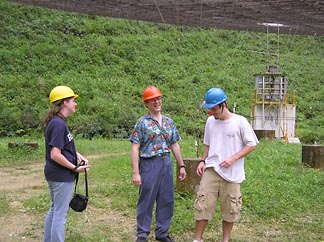Undergraduates study astronomy and atmospheric science during summer program at Arecibo
By Lauren Gold

ARECIBO, PUERTO RICO -- Talia Kohen always pictured herself in law school after college. But she figured that plan left her free to pursue a bachelor's degree in pretty much anything, so she decided to indulge her analytical side and spend her undergraduate years studying electrical engineering.
Somewhere on the way to law school, though, the Cornell University senior from New York City got sidetracked. And she landed in a crowded little office on a steep hill in northwestern Puerto Rico, just a few steps from the world's biggest and most sensitive single dish radio telescope.
Kohen is one of about a dozen undergraduate students spending this summer at the Arecibo Observatory, which is run by the National Astronomy and Ionosphere Center at Cornell University for the National Science Foundation (NSF). The students are at Arecibo through the Research Experiences for Undergraduates (REU) program, an NSF program that gives undergraduates from around the world hands-on experience in radio astronomy, planetary radar astronomy and atmospheric science (aeronomy). The students, in various majors and years, are assigned a 10-week project with a staff scientist, and at the end of the summer they present their results to the observatory community.
This year, REU students come from schools around the United States, including the University of Washington, University of Colorado, University of California-Berkeley, Oberlin College, the State University of New York at Albany, and universities in Puerto Rico. They all live onsite, sharing small cabins (like Jodie Foster's cabin in the movie "Contact") or dormitory rooms. On weekends they explore the island and sharpen their scuba diving skills.
Many, like Adam Mott, an REU student two years ago and now a Ph.D. student at Arizona State University, return to the observatory as graduate students, postdocs or visiting scientists. Mott is back to study fast-spinning stars called pulsars. He says it is the opportunity to ask questions -- and to mingle with seasoned scientists -- that makes REU valuable. "You get to meet people from all over," he said. "The observations are a small part of it."
Kohen's research project is in aeronomy -- specifically, studying variations in neutral wind patterns in the thermosphere (a region around 150 km above the earth's surface). The results could have important implications for satellite-based communications systems, which can be disrupted by phenomena in the upper atmosphere.
It's more complex than anything Kohen has done in classes so far, so she has been reading old papers on the subject, breaking them down sentence by sentence when she has to. "It's really hard for this topic," she said. "There doesn't seem to be anything basic or elementary. But what I've noticed about here is, you can be honest if you don't know something. It's okay to say 'I don't know everything.'"
Kohen hopes at the end of the summer she will have good results to offer. "But what's more important is walking away feeling like I understand the science behind it."
Law school, in the meantime, is still a possibility. But probably not right away.
"I'll go with this," she said, "and see where it takes me."
Media Contact
Get Cornell news delivered right to your inbox.
Subscribe